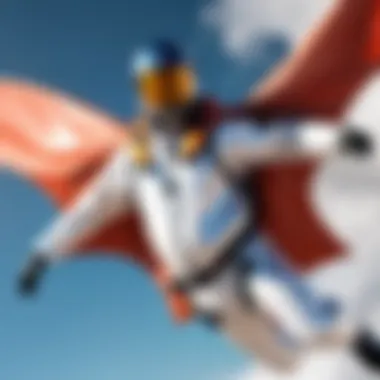Wingsuit Flying: The Art and Science of Freefall


Intro
Wingsuit flying represents a thrilling juxtaposition of art and science that captivates the imagination and pushes the boundaries of human capability. In its essence, this sport combines elements of aerodynamics, physics, and raw human courage, offering enthusiasts a chance to dance through the skies in a manner akin to flying. It’s not just an escape from Earth; it’s a comprehensive experience encompassing history, technology, safety, and personal growth.
The origins of wingsuit flying can be traced back to the mid-20th century, but it was in the 1990s when the sport truly gained momentum. With roots in base jumping, the wingsuit enabled seasoned jumpers to experience a new level of buoyancy and control. The suits, initially rudimentary, have seen a staggering evolution over the years, featuring advanced materials and designs that allow pilots to harness the wind in increasingly sophisticated ways.
However, flying like a bird does not come without its trials and tribulations. Understanding the technical intricacies, from navigating air currents to managing equipment, is crucial. Moreover, let’s not overlook the psychological and physiological challenges that wingsuit pilots grapple with. There exists a dichotomy between the thrill of flight and the sobering reality of the risks involved. This article aims to peel layers off this unique activity, diving deep into its culture, community and technology, with an eye on the horizon for those eager enough to follow suit.
In the coming sections, we will explore diverse aspects of wingsuit flying, from technological insights to the community that thrives on shared experiences in the air.
"To me, wingsuit flying is the ultimate expression of freedom. You are not bound by the ground but instead, you embrace the elements." - Anonymous Wingsuit Pilot
Get ready to leap into the exhilarating world of wingsuit flying, where each jump becomes both a science experiment and a work of art.
Historical Background of Wingsuit Flying
The journey of wingsuit flying is as much about human ingenuity and dreams of flight as it is about the tangible technology that enables it. By delving into the historical background, we not only honor the pioneers who dared to leap into the unknown but also gain insights into how their bold efforts shaped this exhilarating sport. Understanding the history brings depth to the appreciation of wingsuit flying; it's not just a modern pastime but a culmination of centuries of attempts at mastering the skies.
Early Experiments in Human Flight
The fascination with soaring high above the earth isn’t a recent phenomenon. One could easily trace its roots back to the ancient Greeks. The myth of Icarus, who fashioned wings from feathers and wax, serves as a testament to humanity's desire to conquer the skies. Yet serious experiments began in the late 19th and early 20th centuries. The first noteworthy attempts were not wingsuits but rather gliders, with pioneers like Otto Lilienthal who, in the late 1800s, famously glided down hills in his handcrafted contraptions.
His success and subsequent crashes taught us valuable lessons about aerodynamics, steering clear from the ground without a parachute, and provided crucial data on handling flight dynamics.
However, it wasn’t until the mid-20th century when the real exploration of wingsuits began. In 1930, a man named Karl Willig made the first recorded jump with a rudimentary wingsuit, essentially a modified parachute that allowed lateral movement during descent. Though crude by today’s standards, these early endeavors paved the way for understanding that controlled descent was not only possible but thrilling.
Development of Modern Wingsuits
The contemporary wingsuit is a far cry from its ancestors. In the late 1990s, innovators like Jari Likka and others integrated design elements that included wings made from synthetic materials. These materials allowed for flexibility and lightness while providing the necessary structural integrity.
A notable milestone was in 1999 when Patrick de Gayardon demonstrated a wingsuit that had an airfoil design. This new technology allowed for much more control over the flight path and glide ratio, enhancing the possibility of maneuverability mid-air. Over the years, different companies and teams have continuously refined wingsuit designs, experimenting with various shapes and sizes to optimize performance further.
Each iteration brought not only improvements in aerodynamics but also innovations aimed at safety. The current trend is for wingsuits to reflect an artist's vision infused with scientific principles, as resembling a tight-fitting jumpsuit with wings that provide lift once you take that leap off the cliff.
Notable Milestones in the Sport
The timeline of wingsuit flying is dotted with remarkable achievements that illustrate both technological advancements and human spirit. In 2003, the first-ever wingsuit BASE jump from a fixed object was successfully accomplished by Jeb Corliss, forever shifting the spotlight onto wingsuit flying from a mere experimental activity to an adrenaline-packed sport.
In 2006, the wingsuit world record was established, with a remarkable flight over the Swiss Alps. Just a few years later, in 2013, a significant advance occurred when BASE jumping expert Roberta Mancino completed a wingsuit flight from one of the highest points in the world, the Himalayas, showing that wingsuit flying had transcended borders.
These milestones not only highlight the growing popularity of the sport but also showcase the relentless human drive to push boundaries. As technology and techniques evolve, the wingsuit flying community continues to attract thrill-seekers and inventors alike, combining art and science in the most dramatic ways.
"The closest thing to flying!"
This phrase captures the essence of wingsuit flying, emphasizing not just the thrill but also the intricate community built around this pursuit.
Understanding Wingsuit Design
Wingsuit design is a critical element in the world of wingsuit flying, impacting not just the flight experience but also safety and performance. An understanding of the nuances involved in wingsuit construction can drastically influence how a pilot interacts with their environment during flight. By grasping key elements like materials, aerodynamic principles, and design variations, enthusiasts and pilots alike can deepen both their appreciation of the sport and their knowledge of the gear they depend on.
Materials Used in Wingsuit Construction
Wingsuits are constructed from specialized materials that cater to both safety and performance. Commonly, these suits are made from a combination of nylon and polyester, which allow for flexibility and durability. The material needs to withstand the pressures of high-speed flight as well as the impact of landing.
The fabric is often treated for water resistance, ensuring that even if a pilot flies through humid or rainy conditions, their suit maintains integrity. Considerations also extend to weight. A lightweight fabric enables better flight efficiency, while a modern wingsuit might incorporate Kevlar or other synthetic fibers, providing additional protection against wear and tear.
"In wingsuit flying, every stitch and every panel can be the difference between a thrilling experience and a hazardous one."
Another important aspect involves the seams. Stitched seams not only need to be strong, but they also need to be aerodynamic. Laser-cut seams, for example, are becoming popular for their smoothness, minimizing drag as a pilot glides through the air.
Aerodynamic Principles Behind Wingsuit Flight
Aerodynamics plays a monumental role in the performance of a wingsuit. The essential concept revolves around two forces: lift and drag. Lift is generated when the pilot's body and the wingsuit interact with airflow, allowing for horizontal movement in the air.
Key aerodynamic principles include:
- Airfoil Design: The way the wings of the suit are shaped directly affects flight performance. Efficient airfoil shapes create more lift while reducing drag.
- Angle of Attack: This refers to the angle between the wingsuit and the airflow. Adjusting this can lead to considerable variations in flight dynamics.
- Surface Area: The amount of surface area that is positioned against the airflow determines how effectively the suit can generate lift or experience drag.
Understanding these principles enables pilots to manipulate their flight path. It’s a dance of sorts, a relationship between pilot intention and environmental response, determining speed and maneuverability in a crucial way.
Design Variations and Their Purposes
Not all wingsuits are crafted equal; there exists a smorgasbord of design variations, each tailored for specific flying experiences.
- Beginner Suits: These are characterized by a larger surface area and better stability, which helps novices get the hang of flying sensation.
- Intermediate Suits: With moderate surface area and more advanced design features, these suits grant pilots greater maneuverability while still being manageable.
- Advanced Suits: Sleek and compact, these are engineered for experienced pilots seeking high-speed performance and intricate aerial tricks.


The presence of a variety of suits allows pilots to select based on their experience level and intended flight style. Furthermore, some wingsuits are outfitted with additional features like flaps for control and winglets for better lift in specific conditions.
The Physics of Wingsuit Flying
Wingsuit flying combines both art and science in a fascinating way. Understanding the physics behind this sport is crucial for pilots to master the intricate balance of forces acting against their bodies during flight. A solid grasp of flight mechanics is the foundation that enhances safety, improves performance, and ultimately contributes to the overall experience of flying.
Understanding Lift and Drag
In the world of wingsuit flying, the concepts of lift and drag are paramount. Lift is the force that helps the pilot ascend or stay aloft, achieved by the wingsuit's design creating a difference in air pressure above and below its surface. When a wingsuit pilot jumps off a cliff or from an airplane, they angle their bodies to maximize this lifting force. This technique allows them to soar like a bird, gliding through the air instead of just plummeting like a stone.
Conversely, drag is the force that opposes forward motion. Imagine trying to drive a car into a strong headwind; the same principle applies to wingsuit pilots. Drag can be influenced by multiple factors, including the suit's fabric, shape, and even the body posture of the pilot. A well-designed wingsuit minimizes drag while maximizing lift, enabling longer flight times and smoother landings.
This interaction between lift and drag not only defines the flight experience but also directly impacts safety and control. A little tweak here and there to the suit’s angle can mean the difference between a graceful glide and a wild descent.
Terminal Velocity and Its Implications
Every skydiver, including wingsuit pilots, reaches terminal velocity – the maximum speed an object can attain while falling through the air. For wingsuit pilots, this velocity can vary significantly depending on their body position and suit configuration. A wingsuit allows for speeds that can be controlled to a degree, offering pilots the ability to slow their descent or to gear up for a more exhilarating plunge.
Typically, a wingsuit pilot may reach terminal velocities between 60 to 120 mph, while a standard skydiver might fall at 120 mph. Understanding how terminal velocity affects flight allows pilots to make informed decisions about their jump – whether they need to descend quickly or glide for longer periods. This knowledge directly influences their safety protocols as well.
Flight Dynamics and Control Techniques
Flight dynamics delve into the behavior of a wingsuit in various conditions. Pilots must develop skills in controlling their suits to navigate effectively through the skies. Several techniques come into play here, such as adjusting the arms and legs, altering head position, and shifting body weight. Each adjustment impacts the suit's orientation, thus influencing lift, drag, and overall control.
Steering is often accomplished through the innate design of the wingsuit itself. The wing area of the suit can be manipulated to provide directional control, allowing pilots to bank into turns or execute aerial maneuvers. The fluidity of these movements rests on the pilot’s understanding of their dynamics and the surrounding environment – an intricate ballet above the ground.
Safety Considerations in Wingsuit Flying
Wingsuit flying is an adrenaline-fueled sport that demands a delicate balance between thrill and safety. Safety considerations are paramount, not only for the individual pilot but also for the broader community of wingsuit enthusiasts. Proper risk assessment, dependable equipment, and rigorous training all play significant roles in reducing the likelihood of accidents. The unique nature of this sport requires every participant to constantly evaluate their environment and readiness before taking flight.
Risk Assessment and Management
Risk assessment in wingsuit flying is not just about understanding personal limits; it extends to environmental factors and gear evaluation. A good wingsuit pilot should approach every flight with a keen eye, ready to assess risks such as wind conditions, terrain, and potential obstacles. For instance, the flight path over a rocky landscape demands greater caution than flying over open fields. The pilot must consider these factors before stepping off the edge.
- Environmental Factors: Pilots must account for local weather conditions, since winds can change in the blink of an eye. A seemingly calm day can quickly turn into a turbulence-filled adventure.
- Equipment Checks: Prior to any flight, ensuring that all gear is functioning properly is essential. This includes examining the wingsuit, helmet, and parachute system for any signs of wear or defect.
- Personal Readiness: Mental and physical preparedness significantly impacts safety. Fatigue, panic, or overconfidence can lead to dangerous choices in the air.
Before you jump, assess your environment and ensure your gear checks out. Being proactive can save lives.
Importance of Parachute Systems
A wingsuit pilot's parachute system is not merely an accessory; it's a lifeline. The parachute must be reliable, easily deployable, and suited for wingsuit flying. There are two primary types of parachutes to consider:
- Main Parachute: It generally opens automatically but can also be activated manually. It's vital that the main chute is compatible with flying after using a wingsuit, as quick deployment is crucial for safe landings.
- Reserve Parachute: This acts as a backup, deployed when the main chute fails. Pilots must thoroughly understand how to use their reserve parachute under various scenarios.
Routine maintenance and checks on parachute systems cannot be stressed enough. Familiarizing oneself with different deployment techniques can also save precious seconds in critical moments.
Training and Certification Requirements
Training is essential for anyone eager to dive into wingsuit flying. This sport requires expertise that goes beyond regular skydiving lessons. Here are the key training elements that new pilots should focus on:
- Foundational Skydiving Skills: Before even considering a wingsuit, one must possess solid skydiving proficiency. A minimum of 200 jumps is often recommended.
- Wingsuit-Specific Techniques: Once a pilot meets the basic jump requirements, they should undergo specialized wingsuit training from certified instructors. This training encompasses aerial maneuvers, proper body positioning, and emergency response practices.
- Certification Programs: Completing a recognized wingsuit certification program not only boosts personal confidence but also establishes credibility within the wingsuit community. This may include practical evaluations and stringent safety assessments.
Cultivating these skills and certifications paves the way for safer experiences, allowing pilots to focus more on the exhilarating feelings that wingsuit flying brings.
Physiological Effects on Wingsuit Pilots
Wingsuit flying is not merely a physical endeavor; it's an elaborate dance between the body and a myriad of forces affecting performance. Understanding the physiological effects on wingsuit pilots is essential for grasping the demands of the sport. As pilots soar through the skies, they experience numerous sensations and responses happening within their bodies that are crucial to their performance and overall experience. The interplay of adrenaline, the impact of G-forces, and the body's ability to adapt over time are vital elements that shape their ability to navigate this exhilarating activity.
Adrenaline and Cognitive Functioning
One notable aspect of wingsuit flying is the thrill that triggers the release of adrenaline, a hormone that significantly alters both physical and mental function. When pilots take that leap from a cliff or airplane, the body floods with adrenaline, igniting a state of heightened awareness. This rush can sharpen focus, enhance reaction times, and increase strength, facilitating a critical response to the rapid changes in their environment.
During such adrenaline-drenched flights, cognitive functioning can become oddly paradoxical. While some may expect panic to set in, many pilots report an increase in clarity and mental performance. This cognitive lift allows for real-time decision-making, which is essential in a fleeting situation.
However, the effects of adrenaline are double-edged. Too much stimulation can lead to a clouded judgment or impaired motor skills if not managed correctly. It’s a fine line that experienced wingsuit pilots walk, exhibiting mental resilience alongside physical acumen.
The Impact of G-forces During Flight
Gravity is an omnipresent force during wingsuit flights, working its magic as pilots cut through the air at exhilarating velocities. With the high-speed descent, pilots experience varying G-forces that can both thrill and challenge their physical endurance.
As they dive, the body is subjected to forces that can be several times the force of gravity itself. This can lead to feelings of weightlessness, often referred to as "the float" but can also increase the burden on the cardiovascular system. Those who are unprepared may find themselves grappling with dizziness or disorientation, particularly during abrupt maneuvers.
Key g-forces effects include:


- Increased heart rate and blood circulation demands.
- Potential blackout or grayout due to rapid changes in orientation.
- Heightened strain on muscles, requiring strength and stamina.
To counteract these impacts, wingsuit pilots must maintain peak physical conditioning, often focusing on cardiovascular and strength training to bolster their bodies against the rigors of flight.
Physiological Adaptations Over Time
As with many high-adrenaline pursuits, wingsuit flying necessitates not just initial fitness, but also ongoing physical adaptations. Regular exposure to flight conditions can lead to physiological changes, helping pilots endure and excel.
Research suggests that pilots develop adaptations such as enhanced lung capacity and improved muscle efficiency. With time, their bodies become adept at handling extreme and fluctuating conditions, making them more resilient.
Notable adaptations include:
- Muscle conditioning: Improved muscle responsiveness and strength.
- Cardiovascular efficiency: Enhanced heart and lung function under stress.
- Mental resilience: Better coping strategies for stress and environmental changes.
As pilots log more hours in the skies, their bodies learn to adapt. These transformations don't happen overnight; it's the result of consistent flight experience and training.
In summary, the physiological effects on wingsuit pilots encompass a blend of thrilling challenges and amazing adaptations. Whether it's the rush of adrenaline, the forces actin on the body during flight, or the gradual physical changes over time, understanding these elements is essential for anyone looking to explore the boundaries of this extraordinary sport.
Psychological Aspects of Wingsuit Flying
Wingsuit flying is not just a thrilling pastime but also a pursuit deeply embedded in the psychological realm. Understanding the psychological aspects of this extreme sport allows us to grasp the motivations and experiences of pilots who take to the sky in fabric wings. The connections between adrenaline, mental fortitude, and community support create a complex web that influences every flight. Each of these facets contributes to a pilot's overall experience, performance, and safety.
The Psychology of Risk-Taking
Risk-taking is an integral part of wingsuit flying. Practitioners find themselves walking a tightrope between exhilaration and danger. The thrill of jumping into the void, with nothing but a wingsuit to slow their descent, is irresistible to many. This fascination can stem from a variety of psychological drives.
Consider sensation-seeking, a personality trait characterized by the need for varied, novel, and intense experiences. Many wingsuit fliers fall into this category, drawn to the height and speed that few other activities offer.
However, risk-taking is not blind. Skilled pilots exhibit a strong sense of calculated risk. They assess their skills, the environment, and potential hazards. Here, a delicate balance exists:
- Intrinsic Motivation: Pilots often describe feelings of freedom and flight that transcend mere adrenaline rushes.
- Personal Challenge: Many embrace the desire to push their limits, achieving new heights—both literally and figuratively.
- Camaraderie: There's a shared understanding among pilots, as they collectively face similar fears and thrills.
These dimensions of risk-taking highlight that it's not just about escaping reality; it's about finding a profound, shared human experience.
Mental Preparation and Focus Strategies
Before each jump, pilots engage in mental preparation rituals that hone their focus and readiness. Concentration is paramount in high-stakes scenarios. A moment of distraction can have dire consequences when gliding at hundreds of miles per hour.
One widely used method is visualization. This strategy allows a pilot to mentally walk through each phase of the flight, from the moment they leap from the plane to the landing perspective. Visualization often involves seeing oneself successfully navigating through varying conditions, preparing for both predictable situations and potential emergencies.
Another effective technique is mindfulness. By remaining fully present and engaged in the moment, pilots can mitigate fear and anxiety. Techniques include focusing on breathing to channel energy and control nerves.
Common Mental Preparation Techniques:
- Meditation: Clearing the mind can enhance focus and minimize intrusive thoughts.
- Breathing Exercises: Regulating breathing patterns helps in managing adrenaline levels.
- Routine Checklists: Developing a pre-jump checklist assists in maintaining focus, ensuring nothing vital is overlooked.
These practices optimize performance while fostering a deeper connection to the flight experience itself.
Community and Social Dynamics Among Pilots
The wingsuit community forms a unique social fabric that intertwines experiences, support, and learning. Pilots often cultivate friendships built on shared thrills and risks, leading to deeper connections that extend beyond the sport itself. This aspect enhances the overall experience, as no one leaps into the sky alone.
"The bonds you create by jumping together are unlike any other. You trust each other with your lives, and that creates a special connection." — Anonymous Wingsuit Pilot
The spirit of camaraderie plays a crucial role, especially for novices. Experienced pilots often mentor newcomers, sharing insights about both technical aspects and psychological resilience in the face of fear. This mentorship promotes a culture of safety and skill development, reducing the risks associated with the sport.
Moreover, community events—like competitions and group jumps—provide pilots with opportunities to interact and showcase their talents. These gatherings enhance the sense of belonging, and pilots find themselves part of a larger narrative.
In summary, the psychological aspects of wingsuit flying encompass risk-taking behaviors, mental preparation techniques, and the enriching effects of community. Understanding these dimensions helps illuminate what propels pilots into the sky, making their shared journey one of both physical and psychological exploration.
Environmental Factors Influencing Wingsuit Flying
Wingsuit flying is an adrenaline-packed sport that seems almost otherworldly, yet it is deeply intertwined with the environment in which it takes place. Understanding the environmental factors that influence the flight is crucial for every wingsuit pilot. This includes considering the launch sites, weather conditions, and altitude. Knowledge of these factors can not only optimize performance but also enhance safety and enjoyment.
Choosing Launch Sites: Terrain and Conditions
Selecting the right launch site is like picking the perfect stage for a performance. The terrain must be conducive to a safe and successful flight. Pilots need to look for open spaces with minimal obstacles, such as trees, buildings, and rocks, that might interfere during takeoff or landing.
Ideal launch sites are typically at higher elevations, which allows for a longer flight time and better glide results once the jump is made. Location choices can vary significantly — a rocky mountain can provide different challenges than the smooth edge of a cliff by the sea. Factors to consider include:
- Accessibility: Is the site easy to reach?
- Surface Conditions: Is it stable and dry, or could debris like rocks present a hazard?
- Visibility: A clear sight line to guide the trajectory is crucial.
- Escape Routes: Understanding paths for emergency landings in case of unforeseen issues.
Whether it’s a mountain range, a flat desert, or a coastal cliff, the characteristics of the launch site can dramatically influence the overall experience.


Weather Conditions and Their Effects
The weather doesn’t just set the mood; it can make or break a jumps. Wingsuit pilots must have a solid grasp of the weather patterns before they leap. Wind, in particular, plays a significant role. Too much wind can add chaos to a flight, while too little can limit glide efficiency. Factors to consider include:
- Wind Speed and Direction: Knowing how these elements will change during a flight is critical.
- Precipitation: Rain and snow can affect visibility and control.
- Temperature: Warmer air can reduce density and affect lift.
Weather conditions should be thoroughly monitored on the day of the jump. A clear blue sky may visually signal a perfect jump, but underlying wind tunnels or a sudden storm can create dangerous conditions.
Altitude and Geographic Considerations
Altitude is not just a number; it can dictate the very nature of a wingsuit flight. Higher altitudes provide the opportunity to cover greater distances before deploying a parachute. Pilots often prefer locations above 3,000 meters for optimal glide ratios. However, they must also take into account the geographic features surrounding them. These might include:
- Terrain Elevation: Higher mountains can lead to launching from various elevations.
- Geographical Landmarks: Rivers or forests below can impact landing and performance.
- Air Density: Altitude can affect the density of the air, and subsequently, lift creation.
Being strategic about altitude and geography can enhance flight performance and make for a safer experience.
"Mastery in wingsuit flying is not just about the suit and skill; it’s about grasping the symbiosis between the flyer and the world below."
The complex interplay of these elements underscores the importance of environmental factors in the art and science of wingsuit flying. Understanding them intricately can yield not just exhilarating flights but also a safer journey through the skies.
Wingsuit Flying in Popular Culture
Wingsuit flying has carved a niche for itself not only as an extreme sport but also as a phenomenon within popular culture. Its incorporation into media, film, and social discourse offers a glimpse of how this thrilling activity resonates with the broader public. The powerful imagery associated with soaring through the skies, coupled with the adrenaline rush of free-falling, captures the imagination and elevates wingsuit flying beyond mere sport. This section explores the unique role that wingsuit flying plays in popular culture, emphasizing representation in media, its influence on extreme sports culture, and public perception alongside prevailing misconceptions.
Representation in Media and Film
Wingsuit flying has found a vibrant space in films and various media outlets, often serving as the centerpiece for high-octane action sequences. Movies like "The Art of Flight" and "Point Break" showcase not only the stunning visuals of flying but also portray the daring nature of the sport. Such portrayals excite viewers, providing them with a bird's-eye view—both literally and figuratively—of an experience that is beyond the reach of normal activities.
"Wingsuit flying portrays the ultimate escape—freedom from gravity, blended with the thrill of speed."
Moreover, social media platforms have amplified this representation. The dynamic footage shared by wingsuit enthusiasts creates a connection among fans and aspiring pilots. Platforms like Instagram and TikTok host a plethora of clips showcasing breathtaking stunts and incredible landscapes that accompany these flights. These visual representations serve as both an inspiration and an aspiration, inviting followers to dream of the impossible.
Influence on Extreme Sports Culture
The rise of wingsuit flying has had a profound impact on extreme sports culture. The sport embodies a lifestyle that celebrates adventure and challenges limits. As a result, it has attracted a diverse following of thrill-seekers looking to push the boundaries of what is physically possible.
Participation in wingsuit flying often reflects a broader trend in extreme sports, such as skydiving and base jumping, which emphasize community and shared experiences. Events and competitions have sprung up globally, drawing in a crowd that not only appreciates the athleticism involved but also enjoys the camaraderie among athletes. This community aspect creates a nurturing environment, inspiring newcomers and veterans alike to share their stories and experiences, further solidifying wingsuit flying's place in extreme sports culture.
Public Perception and Misconceptions
Despite its rising popularity, wingsuit flying also suffers from misconceptions that skew public perception. Many view it as a reckless act, dismissing the extensive training and careful planning that goes into each flight. Such misunderstandings often paint the activity in a negative light, leading to an oversimplified view of what being a wingsuit pilot entails.
Conversations surrounding safety gear, regulatory guidelines, and the importance of rigorous training can help clarify these misconceptions. Pilots undergo extensive training and must often log numerous jumps to be considered competent. By addressing these points, the public may come to appreciate wingsuit flying not as an impulsive thrill-seeking endeavor, but as an intricate art that demands precision, skill, and respect for the environment.
Future Directions in Wingsuit Technology
As wingsuit flying grows in popularity, so does the need for innovation in the technology that underpins this thrilling sport. Pilots are always looking for ways to maximize performance, enhance safety, and improve overall experience while soaring through the skies. The importance of future directions in wingsuit technology cannot be overstated, as advancements in materials, safety equipment, and design trends can significantly alter the landscape of wingsuit flying. Not only do these improvements promise to make the sport accessible to a broader audience, but they also foster an environment where precision and safety can harmoniously co-exist with the adrenaline rush that drew enthusiasts to the activity in the first place.
Innovative Materials and Their Potential
The fabrics and materials that make up a wingsuit have evolved dramatically over the years. Early models largely relied on polyester and nylon, which offered limited flexibility and durability. Today, manufacturers are exploring innovative materials such as Dyneema, a high-strength polyethylene fiber, known for its lightweight and durability. This material enables the creation of wingsuits that not only withstand extreme conditions but also provide the necessary aerodynamic properties required for optimal performance in the air.
In addition to Dyneema, the use of advanced composites is turning heads in the wingsuit community. These materials can be engineered to have specific properties, catering to different styles of flying and varying environmental conditions. As researchers delve deeper into material science, possibilities such as temperature regulation and self-repairing fabrics may even come to fruition, which could redefine how pilots experience their jumps.
Here are some potential benefits of these innovative materials:
- Enhanced Durability: New materials resist wear and tear, providing longer-lasting equipment.
- Weight Reduction: Lighter fabrics can improve maneuverability and lift.
- Increased Safety: Advanced composites could mitigate the risk of structural failure during flight.
Technological Advancements in Safety Equipment
Safety is an ongoing concern for wingsuit flyers. While the thrill of soaring through the skies is alluring, the risks associated with wingsuit flying have led to the development of specialized safety equipment. Recent advancements have made leaps in parachute technology, focus largely on reliability and deployment efficiency. For instance, automatic activation devices (AADs) are becoming a standard in safety gear, automatically deploying a parachute under critical circumstances.
Bringing this technology further into the spotlight are customizable parachute systems that allow pilots to tailor openings based on personal preferences and flight characteristics. This flexibility grants wingsuit pilots not only a reassuring sense of safety, but also builds confidence in each flight.
Key advancements include:
- Smart Parachute Systems: Systems that monitor altitude and speed can adjust deployment timing, reducing the chance of malfunctions.
- Backup Systems: Double-layer parachute systems ensure that if one fails, another is ready to deploy.
- Wearable Tech: Integrated devices that monitor heart rate, adrenaline levels, and other physiological metrics in real-time to offer insights post-jump.
"Staying ahead in safety technology elevates the experience of wingsuit flying to new heights, ensuring that pilots can focus on mastering their art while limiting the risks they face."
Emerging Trends in Wingsuit Design
Wingsuit design is witnessing a renaissance of sorts, fueled by the integration of cutting-edge technology. One of the most notable trends in recent years has been the shift towards more aerodynamically efficient silhouettes. Manufacturers are employing computer-aided design (CAD) to optimize the shape of wingsuits, enhancing lift capabilities without compromising on performance.
The rise of personalized wingsuits also marks a significant trend. Pilots are now able to customize their gear based on their experience, size, and style of flying. This trend is coupled with the increasing popularity of freestyle wingsuit flying, which requires specific design considerations for maneuverability as well as the ability to perform aerial tricks.
Some emerging design trends include:
- Hybrid Designs: Combining features from traditional wingsuits and parachutes to offer diverse flight capabilities.
- Multifaceted Wing Structures: These new forms can adapt to varying flight conditions, effectively altering the wingsuit’s shape as a pilot navigates through the air.
- Interactive Suits: Integrating electronics and sensors into the wingsuit fabric to collect flight data and enhance performance metrics.
As technology continues to evolve, the future of wingsuit flying promises exciting advancements. Embracing these innovative materials, safety equipment, and design trends will ultimately lead to more exhilarating experiences for pilots and usher in new participants to the sport.







